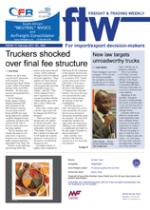Truckers are up in arms
over the newly announced
tariff structure of the
Gauteng Open Road Tolling
system, which will see them
having to fork out R3.96 a
kilometre – 46 cents more
than the anticipated R3.50 a
kilometre.
The SA National
Roads Agency Limited
(Sanral) announced the
tariff structure for the
185-kilometre Gauteng
Freeway Improvement
Project (GFIP) last week,
saying light motor vehicles
would be charged 66 cents
a kilometre and heavy-duty
vehicles R3.96. This is,
however, before discounts
have been applied.
“The fee structure will
include discounts for offpeak
travel, e-tag users,
frequent users and qualifying
public transport operators,”
said Sanral CEO, Nazir Alli.
Toll fees on the multi-lane
free-flowing GFIP, also
known as the open road toll
system, will be collected
through a series of overhead
toll points (gantries). “These
gantries are fitted with toll
collection equipment that
will recognise the electronic
transender (e-tag) on a
vehicle,” said Alli. “Tolls
will be deducted from a
user’s registered e-toll
account associated with the
vehicle and the user will be
able to travel without any
disruptions.”
Heavy-duty vehicles fitted
with the e-tag system will
be charged only R2.97 per
kilometre.
“There are many trucks
though that won’t qualify
for all the discounts,” says
Road Freight Association
spokesman, Gavin Kelly.
“The impact of these toll
fees is going to be huge and
it will impact the economy
negatively as the goods on
the shelves will ultimately
increase in cost.”
According to Kelly an
impact study conducted in
2010 using R3.50 a kilometre
as the measure showed some
goods would increase in cost
by as much as 25%. “In this
system some goods will be
tolled three or four times.
We tabled our concerns at
the time to the Ministries
of Transport and Trade and
Industry. One must also take
into account that this study
was done without taking
the increase of fuel into
consideration.”
The RFA has been in
talks with Sanral for several
years around the toll system,
but was never involved in
discussions around the actual
fee structure. “At some point
though they became very
cagey about the actual price,
claiming it was confidential
or complicated and finally in
the last couple of months we
had no interaction.”
Kelly said they were
shocked at the final fee
structure as it was more than
was expected. “We are going to do
another impact study with an
economist to try to determine
what the real increase in cost
is going to be. We will also
have to take the fuel price
into consideration as it is
expected to keep climbing
this year.”
He said the impact on
operating costs would
depend on fleet sizes and
how much the tolled ring
road is used, but in some
cases the bill would be a
few million rand a month.
“That money is going to be
recouped from somewhere
and it will be the consumer.”
He said while there were
not necessarily alternative
routes, the toll road would
result in heavier traffic in
suburban areas as people
tried to find other ways of
reaching their destination.
“And that does not just
mean heavy duty trucks but
rather all traffic is going to
increase on the ‘alternative’
roads in the province. We
continue to ask the question:
“Was the toll road system
really necessary for Gauteng
and has anyone really taken
the impact on the economy
into consideration?”
According to Alli
discounts on the system will
make all the difference as
users will also be discounted
on the frequency they use the
ring road and at what times
they drive.
Revenue created through
tolls will be used to foot the
bill of the improved freeway
estimated in the region of
R20 billion.
Road users will be
required to set up an account
with Sanral for the payment
of the their toll fees. Each
time a vehicle passes
underneath a gantry, tolls
will be charged. The cost per
gantry is determined by the
kilometre distance, which
the toll point represents. The
toll tariff is calculated by
multiplying this distance,
represented by the toll point,
with the cents per kilometre
rate. Gantries are situated on
average between five and 14
kilometres apart.
On this network a
directional toll strategy will
be implemented. This means
at any one specific position,
only one direction of the
route is tolled.
According to Alli the
system will enter a test
phase in April this year.
It is expected to be fully
operational by no later than
June 23.
Truckers shocked over final fee structure
11 Feb 2011 - by Liesl Venter
0 Comments
FTW - 11 Feb 11

11 Feb 2011
11 Feb 2011
11 Feb 2011
11 Feb 2011
11 Feb 2011
11 Feb 2011
Border Beat
Featured Jobs
New
New
